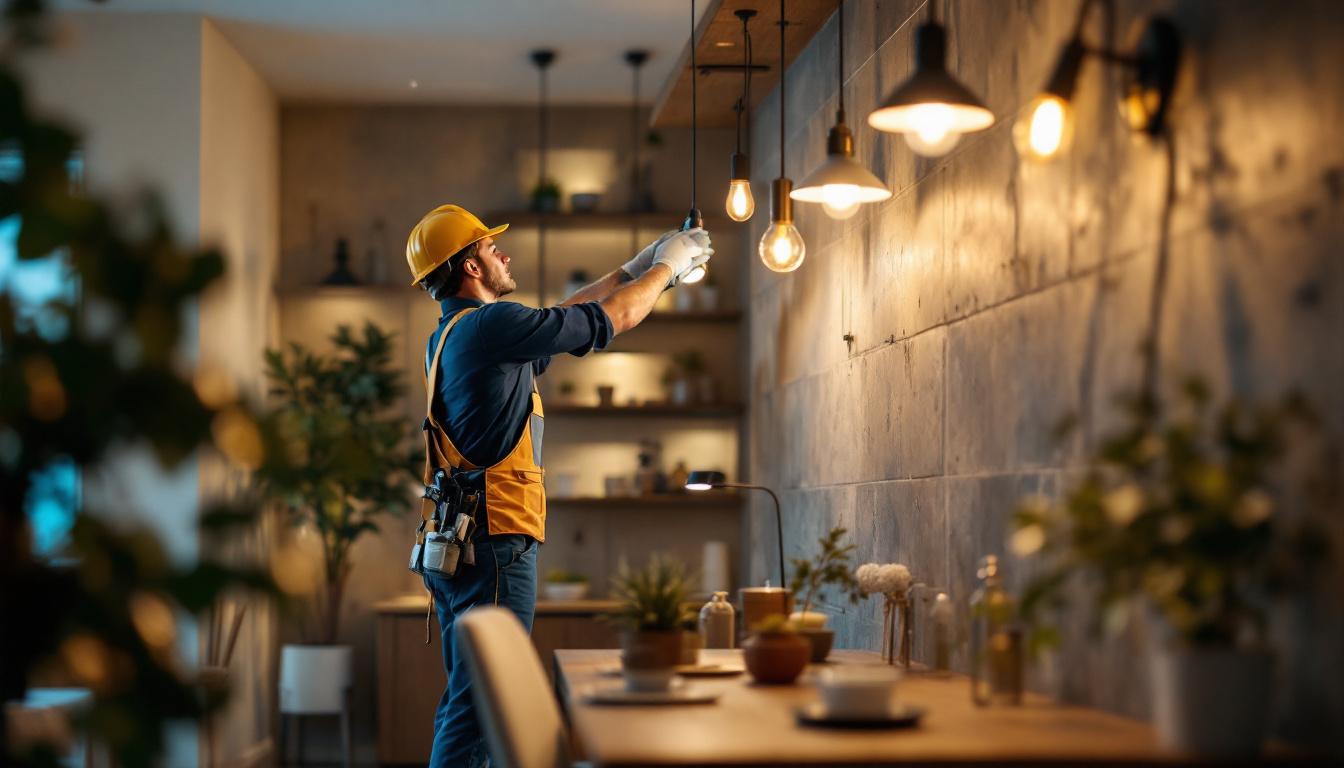
One of the most common challenges lighting contractors face is striking the right balance between aesthetics and functionality. Homeowners want lighting that complements their interior design, enhances architectural features, and creates the desired ambiance. At the same time, the lighting must be practical—providing sufficient illumination for everyday activities without causing glare or discomfort.
Achieving this balance requires a deep understanding of different types of lighting—ambient, task, and accent—and how they work together in a space. For example, a kitchen might need bright, shadow-free task lighting for cooking, while the living room benefits from softer, layered lighting that sets a cozy mood. Contractors must carefully select fixtures, bulbs, and placement to meet these diverse needs.
Additionally, homeowners increasingly expect lighting to be customizable. Dimmable lights and smart controls allow users to adjust brightness and color temperature throughout the day. Incorporating these technologies adds complexity to the design and installation process, but it’s essential for delivering a lighting solution that feels both beautiful and functional.
Moreover, the choice of materials and finishes for light fixtures can greatly influence both the aesthetic and practical aspects of lighting. For instance, fixtures made from natural materials like wood or stone can add warmth and texture to a room, while sleek metal designs may convey a more modern, minimalist vibe. Understanding the interplay between these materials and the overall design theme of a space is crucial for contractors aiming to create a cohesive look. Additionally, the energy efficiency of the lighting solutions is becoming a priority for many homeowners, prompting contractors to explore options like LED fixtures, which not only reduce energy consumption but also come in a variety of styles that can seamlessly blend into any decor.
Furthermore, the placement of lighting fixtures plays a pivotal role in achieving the desired effect. Strategic positioning can enhance the room’s functionality and highlight key features, such as artwork or architectural details. For example, wall sconces can draw attention to a textured wall, while pendant lights can serve as a focal point above a dining table. This thoughtful approach to placement ensures that the lighting not only serves its purpose but also contributes to the overall aesthetic narrative of the space, creating an environment that feels both inviting and well-designed.
Energy efficiency is no longer optional-it’s a priority for most clients and often mandated by local building codes. Lighting contractors must stay current with evolving standards and technologies to recommend and install systems that minimize energy consumption without sacrificing performance.
LED lighting has become the go-to solution for energy-conscious homeowners. It offers long life, low heat output, and significant energy savings compared to incandescent or halogen bulbs. However, selecting the right LED products involves more than just choosing the most energy-efficient option. Color rendering index (CRI), color temperature, and compatibility with dimmers and smart controls all influence the final lighting quality. Additionally, the environmental impact of LED production and disposal is an increasingly important consideration, prompting contractors to seek out manufacturers who prioritize sustainable practices in their supply chains.
Contractors also face challenges when retrofitting older homes. Existing wiring and fixtures may not support modern lighting technologies, requiring upgrades that can increase costs and complexity. Educating clients about these trade-offs and managing expectations is a critical part of the process. Furthermore, the integration of smart home technology adds another layer of complexity; contractors must ensure that the new systems are not only compatible with existing infrastructure but also user-friendly for homeowners who may be less tech-savvy. This often involves providing thorough demonstrations and ongoing support to help clients fully realize the benefits of their new lighting systems.
Moreover, as energy efficiency standards continue to evolve, contractors must also be proactive in understanding incentives and rebates available for energy-efficient upgrades. Many local governments and utility companies offer financial incentives to encourage homeowners to invest in energy-saving technologies, which can significantly offset installation costs. By staying informed about these programs, contractors can provide valuable guidance to clients, helping them navigate the financial landscape while promoting sustainable practices. This not only enhances client satisfaction but also positions contractors as trusted advisors in the field of energy efficiency and sustainability.
Older homes often come with hidden surprises. Outdated wiring, insufficient circuits, or non-standard electrical panels can complicate lighting installations. Safety is paramount, so contractors must thoroughly assess the existing infrastructure before proceeding. This evaluation often includes checking for code compliance, which can vary significantly based on local regulations. Homeowners may be surprised to learn that what was once considered acceptable may no longer meet current safety standards, necessitating upgrades that can add both time and expense to the project.
Structural constraints can also limit fixture placement. For example, low ceilings may restrict the use of chandeliers or pendant lights, while load-bearing walls might prevent running new wiring where it’s most convenient. Creative problem-solving is essential—sometimes lighting designers must think outside the box, using surface-mounted fixtures or wireless controls to overcome these obstacles. Additionally, the choice of materials can play a significant role; lightweight, low-profile fixtures can provide effective illumination without overwhelming a space, while strategically placed mirrors can enhance the perceived height of a room, making it feel more open and inviting.
In new construction, contractors have more freedom but must coordinate closely with builders and electricians to ensure lighting plans align with the overall design and electrical layout. Early collaboration can prevent costly changes later on. Furthermore, incorporating smart home technology into the initial design can enhance both functionality and energy efficiency. By planning for integrated systems that allow for automated lighting control, homeowners can enjoy the benefits of modern convenience while also reducing their energy consumption. This foresight not only adds value to the home but also creates a more adaptable living space that can evolve with the owners’ needs over time.
Lighting is highly subjective. What feels warm and inviting to one person might seem dim or yellowish to another. Contractors must develop strong communication skills to understand client preferences and explain technical details clearly. This involves not only listening to clients but also asking the right questions to uncover their true desires and concerns. For instance, a client may express a preference for bright, white lighting, but upon further discussion, they might reveal that they are looking for a cozy atmosphere for evening gatherings. This nuanced understanding can lead to more tailored and satisfactory lighting solutions.
Visual tools like 3D renderings and mock-ups can help clients visualize the final result. Demonstrations of different bulb types and color temperatures in the actual space are invaluable. It’s also important to set realistic expectations about costs, timelines, and potential challenges. Providing clients with a detailed breakdown of the project phases can demystify the process and foster trust. Additionally, offering a range of options—from budget-friendly choices to high-end fixtures—ensures that clients feel empowered to make informed decisions that align with their financial constraints.
Some clients may request trendy or elaborate lighting designs that don’t suit their home’s style or budget. Navigating these conversations tactfully while guiding clients toward practical, long-lasting solutions is a key part of the contractor’s role. This might involve showcasing case studies of previous projects that highlight the benefits of more classic designs or suggesting alternatives that maintain the desired aesthetic without compromising functionality. Furthermore, educating clients about the long-term maintenance and energy efficiency of different lighting options can help them appreciate the value of investing in quality solutions that will stand the test of time.
Moreover, establishing a feedback loop throughout the project can enhance client satisfaction. Regular check-ins and progress updates not only keep clients informed but also allow for adjustments based on their evolving preferences. Encouraging clients to share their thoughts during the installation process can lead to a more collaborative environment, where their input is valued and incorporated. This proactive approach not only strengthens the contractor-client relationship but also ensures that the final lighting design truly reflects the client’s vision and lifestyle.
Smart lighting systems offer convenience, energy savings, and enhanced control, but they add layers of complexity to installation and troubleshooting. Contractors must be familiar with various platforms and protocols, such as Zigbee, Z-Wave, or Wi-Fi-based systems, to recommend solutions that integrate seamlessly with other smart home devices.
Compatibility issues can arise when mixing brands or trying to retrofit smart controls into existing wiring. Proper planning and testing are essential to avoid frustrating user experiences. Additionally, contractors should be prepared to provide ongoing support as clients learn to use their new systems.
Security and privacy concerns around connected devices are another consideration. Educating clients about safe practices and choosing reputable products can help mitigate risks.
Lighting contractors must comply with a wide range of safety codes and regulations. These cover everything from fixture placement to wiring methods and emergency lighting requirements. Staying up-to-date with local and national standards is critical to avoid violations and ensure homeowner safety.
For example, bathrooms and outdoor areas require fixtures rated for damp or wet locations. Improperly installed lighting can lead to electrical hazards or fire risks. Contractors should also be aware of regulations related to energy efficiency, such as maximum wattage limits and mandatory use of certain technologies.
Documentation and permits are often required, adding administrative tasks to the contractor’s workload. Thorough record-keeping and clear communication with inspectors help streamline the approval process.
Lighting contractors face a multifaceted set of challenges when working on residential projects. From blending beauty with utility to navigating technical and regulatory hurdles, success depends on a combination of technical expertise, creativity, and communication skills.
Understanding client needs, staying current with technology, and anticipating potential obstacles allow contractors to deliver lighting solutions that enhance homes and satisfy homeowners. While the challenges are significant, the rewards-transforming spaces through light-are well worth the effort.
Ready to overcome the challenges of residential lighting and elevate your projects to new heights? At LumenWholesale, we provide lighting contractors with the tools to master both the art and science of lighting. Our extensive range of spec-grade lighting products combines quality with affordability, ensuring you can deliver exceptional results without compromise. Say goodbye to inflated markups and hello to hassle-free bulk buying with free shipping. Make your next project shine brighter by choosing Wholesale Lighting at the Best Value with LumenWholesale.

Explore how LED base technology is revolutionizing the lighting industry and impacting contractors’ profits.

Discover the diverse world of light switches and their top benefits for lighting contractors.

Discover the key features and benefits of motion-activated outdoor LED lights that every lighting contractor should know.

Discover essential insights into decorative lamp posts with our comprehensive guide tailored for lighting contractors.